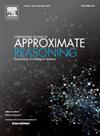Sensitivity analysis to unobserved confounding with copula-based normalizing flows
IF 3
3区 计算机科学
Q2 COMPUTER SCIENCE, ARTIFICIAL INTELLIGENCE
引用次数: 0
Abstract
We propose a novel method for sensitivity analysis to unobserved confounding in causal inference. The method builds on a copula-based causal graphical normalizing flow that we term ρ-GNF, where is the sensitivity parameter. The parameter represents the non-causal association between exposure and outcome due to unobserved confounding, which is modeled as a Gaussian copula. In other words, the ρ-GNF enables scholars to estimate the average causal effect (ACE) as a function of ρ, accounting for various confounding strengths. The output of the ρ-GNF is what we term the , which provides the bounds for the ACE given an interval of assumed ρ values. The also enables scholars to identify the confounding strength required to nullify the ACE. We also propose a Bayesian version of our sensitivity analysis method. Assuming a prior over the sensitivity parameter ρ enables us to derive the posterior distribution over the ACE, which enables us to derive credible intervals. Finally, leveraging on experiments from simulated and real-world data, we show the benefits of our sensitivity analysis method.
基于copula的归一化流对未观测混杂的敏感性分析
我们提出了一种对因果推理中未观察到的混杂因素进行敏感性分析的新方法。该方法建立在一个基于copula的因果图归一化流上,我们称之为ρ- gnf,其中ρ∈[−1,+1]是灵敏度参数。该参数表示由于未观察到的混杂而导致的暴露与结果之间的非因果关联,其建模为高斯联结。换句话说,ρ- gnf使学者能够估计平均因果效应(ACE)作为ρ的函数,考虑到各种混杂强度。ρ- gnf的输出就是我们所说的ρ曲线,它提供了给定假定ρ值区间的ACE的界。ρ曲线还使学者能够识别使ACE无效所需的混杂强度。我们还提出了灵敏度分析方法的贝叶斯版本。假设灵敏度参数ρ的先验使我们能够推导出ACE的后验分布,从而使我们能够推导出可信区间。最后,利用模拟和真实数据的实验,我们展示了灵敏度分析方法的优点。
本文章由计算机程序翻译,如有差异,请以英文原文为准。
求助全文
约1分钟内获得全文
求助全文
来源期刊

International Journal of Approximate Reasoning
工程技术-计算机:人工智能
CiteScore
6.90
自引率
12.80%
发文量
170
审稿时长
67 days
期刊介绍:
The International Journal of Approximate Reasoning is intended to serve as a forum for the treatment of imprecision and uncertainty in Artificial and Computational Intelligence, covering both the foundations of uncertainty theories, and the design of intelligent systems for scientific and engineering applications. It publishes high-quality research papers describing theoretical developments or innovative applications, as well as review articles on topics of general interest.
Relevant topics include, but are not limited to, probabilistic reasoning and Bayesian networks, imprecise probabilities, random sets, belief functions (Dempster-Shafer theory), possibility theory, fuzzy sets, rough sets, decision theory, non-additive measures and integrals, qualitative reasoning about uncertainty, comparative probability orderings, game-theoretic probability, default reasoning, nonstandard logics, argumentation systems, inconsistency tolerant reasoning, elicitation techniques, philosophical foundations and psychological models of uncertain reasoning.
Domains of application for uncertain reasoning systems include risk analysis and assessment, information retrieval and database design, information fusion, machine learning, data and web mining, computer vision, image and signal processing, intelligent data analysis, statistics, multi-agent systems, etc.
 求助内容:
求助内容: 应助结果提醒方式:
应助结果提醒方式:


